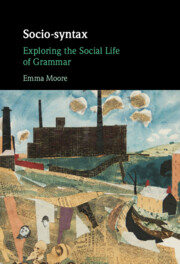Book contents
- Socio-syntax
- Socio-syntax
- Copyright page
- Dedication
- Contents
- Figures
- Tables
- Acknowledgements
- 1 Why Does the Social Meaning of Grammar Matter?
- 2 The Social Landscape of Midlan High
- 3 How Do We Study the Social Meaning of Grammatical Variation?
- 4 How Free Are We to Vary the Grammar We Use?
- 5 How Do We Use Grammar to Design Our Talk?
- 6 Does Everyone Use Grammar to Make Social Meaning?
- 7 How Does Grammar Combine with Other Elements of Language?
- 8 What Does It Mean to View Grammar as a Fluid, Flexible Social Resource?
- References
- Index
3 - How Do We Study the Social Meaning of Grammatical Variation?
Published online by Cambridge University Press: 19 October 2023
- Socio-syntax
- Socio-syntax
- Copyright page
- Dedication
- Contents
- Figures
- Tables
- Acknowledgements
- 1 Why Does the Social Meaning of Grammar Matter?
- 2 The Social Landscape of Midlan High
- 3 How Do We Study the Social Meaning of Grammatical Variation?
- 4 How Free Are We to Vary the Grammar We Use?
- 5 How Do We Use Grammar to Design Our Talk?
- 6 Does Everyone Use Grammar to Make Social Meaning?
- 7 How Does Grammar Combine with Other Elements of Language?
- 8 What Does It Mean to View Grammar as a Fluid, Flexible Social Resource?
- References
- Index
Summary
Sound empirical analysis draws upon (and refines) theories about a particular set of concepts, and understanding the social meaning of grammatical variation requires that we study language as it relates to social practice and forms of social engagement. Chapter 3 interrogates how sociolinguists study social meaning and the processes involved in meaning making. It explains the concepts that we need to know to understand how social meaning develops (the sign, style, persona, social type, indexicality, character type, stance, index, icon, sound symbolism, qualia, rhematisation, indexical field, stance accretion, erasure, axis of differentiation, and enregisterment), providing detailed exemplification from the Midlan High dataset. The chapter also considers the techniques required to understand how these concepts operate (experimental perception studies, ethnography, pragmatic analysis). Given that social meaning may interact with pragmatics, this chapter also highlights the need to combine research on the pragmatics of spoken language with variationist work on the social embedding and social distribution of linguistic variables.
- Type
- Chapter
- Information
- Socio-syntaxExploring the Social Life of Grammar, pp. 46 - 74Publisher: Cambridge University PressPrint publication year: 2023



